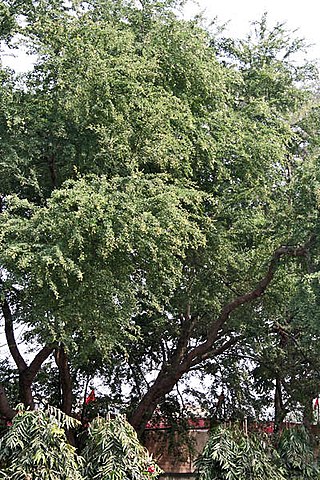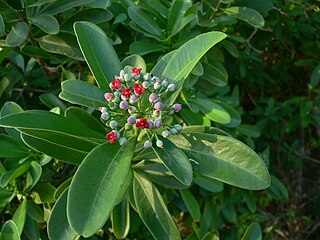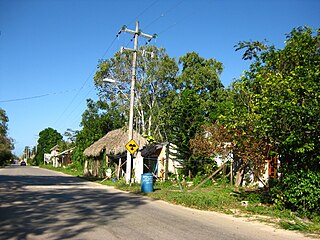
Tamarind is a leguminous tree bearing edible fruit that is indigenous to tropical Africa and naturalized in Asia. The genus Tamarindus is monotypic, meaning that it contains only this species. It belongs to the family Fabaceae.

The bee hummingbird, zunzuncito or Helena hummingbird is a species of hummingbird, native to the island of Cuba in the Caribbean. It is the smallest known bird.

The Key West Tropical Forest & Botanical Garden is a frost-free arboretum and botanical garden containing a collection of trees, shrubs, and palms, including several "champion tree" specimens. It is located on Stock Island in the municipality of Key West, Florida, United States. It is open daily. There is a nominal fee for admission, with free admission for locals on the first Sunday of every month.
Sabicu wood or sabicu is the wood of at least two species of the genus Lysiloma. Lysiloma sabicu (L.) Benth. occurs sparingly in the Bahamas, Jamaica, Haiti and the Dominican Republic, and Cuba. It was named by George Bentham (1800-1884) from a Cuban specimen examined in 1854. Bentham went on to identify a second species, Lysiloma latisiliquum (L.) Benth., which grows best in the Bahamas. The latter is commonly known as 'wild tamarind' or 'false tamarind'. The wood of both species is similar, being mid-brown in colour, sometimes with a reddish hue, heavy hard and durable. Some timber is well figured, but most relatively plain. The wood has been used in construction, shipbuilding and in furniture making, although its weight is a distinct drawback for the latter purpose. The stairs of The Crystal Palace in London, in which The Great Exhibition of 1851 was held, were made of sabicu due to its durability. Despite the enormous traffic that passed over them, the wood at the end was found to be little affected by wear.

Leucaena is a genus of flowering plants in the mimosoid clade of the subfamily Caesalpinioideae of the family Fabaceae. It contains about 24 species of trees and shrubs, which are commonly known as leadtrees. They are native to the Americas, ranging from Texas in the United States south to Peru. The generic name is derived from the Greek word λευκός (leukos), meaning "white," referring to the flowers.

Pithecellobium dulce, commonly known as Manila tamarind, Madras thorn, monkeypod tree or camachile, is a species of flowering plant in the pea family, Fabaceae, that is native to the Pacific Coast and adjacent highlands of Mexico, Central America, and northern South America. It is also sometimes known as monkeypod, but that name is also used for several other plants, including Samanea saman. It is an introduced species and extensively naturalized in the Caribbean and Florida, as well as the Philippines and Guam via the Manila galleons. It has also been introduced to Thailand and South Asia, It is considered an invasive species in Hawaii.

The greenhouse frog is a species of frog in the family Eleutherodactylidae, native to Cuba, the Bahamas, and the Cayman Islands, and it has been introduced to other areas, such as Florida, Hawaii, Guam, Hong Kong and Shenzhen.

Lyle's flying fox is a species of flying fox in the family Pteropodidae. It is found in Cambodia, Thailand and Vietnam, with an outlying population in Yunnan, China. It faces persecution from farmers and it is killed for bushmeat in parts of its range. The International Union for Conservation of Nature has rated its conservation status as being "vulnerable".

Liguus is a genus of large tropical air-breathing land snails, more specifically arboreal or tree snails, terrestrial pulmonate gastropod mollusks in the family Orthalicidae.
The Bahamian dry forests are a tropical and subtropical dry broadleaf forest ecoregion in the Bahamas and the Turks and Caicos Islands, covering an area of 4,900 km2 (1,900 sq mi). They are found on much of the northern Bahamas, including Andros, Abaco, and Grand Bahama, where they are known as coppices. Dry forests are distributed evenly throughout the Turks and Caicos.

Liguus fasciatus, the Liguus Tree Snails, also known as "living jewels", is a species of air-breathing land snail, a tree snail, a terrestrial pulmonate gastropod mollusk in the family Orthalicidae.

Lysiloma is a genus of flowering plants in the family Fabaceae.

Canella is a monospecific genus containing the species Canella winterana, a tree native to the Caribbean from the Florida Keys to Barbados. Its bark is used as a spice similar to cinnamon, giving rise to the common names cinnamon bark, wild cinnamon, and white cinnamon.

Macaria abydata, commonly known as the dot-lined angle, is a moth of the family Geometridae. It is native from northern Argentina to the Caribbean and southern United States. It has been introduced to the Pacific and has spread rapidly since. The first introduction occurred in Hawaii in 1970. Further spread occurred as follows:

The South Florida rocklands ecoregion, in the tropical and subtropical moist broadleaf forests biome, occurs in southern Florida and the Florida Keys in the United States, where they would naturally cover an area of 2,100 km2 (810 sq mi). These forests form on limestone outcrops with very thin soil; the higher elevation separating them from other habitats such as coastal marshes and marl prairies. On mainland Florida, rocklands exist primarily on the Miami Rock Ridge, which extends from the Miami River south to Everglades National Park. South Florida rocklands are further divided into pine rocklands and rockland hammocks.

Solferino is a small town located in the municipality of Lázaro Cárdenas in the state of Quintana Roo, Mexico.

Dialium guineense, the velvet tamarind, is a tall, tropical, fruit-bearing tree in the flowering plant family Fabaceae. It has small, typically grape-sized, edible fruits with brown, hard, inedible shells.
Cryptothecia evergladensis is a species of corticolous (bark-dwelling) and crustose lichen in the family Arthoniaceae. Found in Florida, USA, it was formally described by lichenologist Frederick Seavey in 2009. The type specimen was collected by Seavey in Everglades National Park in a cypress strand. The specific epithet refers to the type locality. The lichen is most often encountered on the bark on Taxodium, but has also been recorded growing on Metopium toxiferum, Sideroxylon salicifolia, Ateramnus lucida, and Lysiloma latisiliquum, and well as on the wood of Conocarpus erectus. Cryptothecia evergladensis contains some secondary compounds, including psoromic acid, 2-O-methylperlatolic acid, and lichexanthone. The last compound, when present in the lichen at sufficient amounts, causes the lichen thallus to fluoresce yellow when shone with a long-wavelength UV light.

Lysiloma divaricatum is a flowering tree native to Mexico and Central America. Common names include mauto, quitaz, and tepemesquite in Mexico, quebracho in Honduras, Mexico, and Nicaragua, and quebracho negro, tepemisque, and yaje in El Salvador.
















